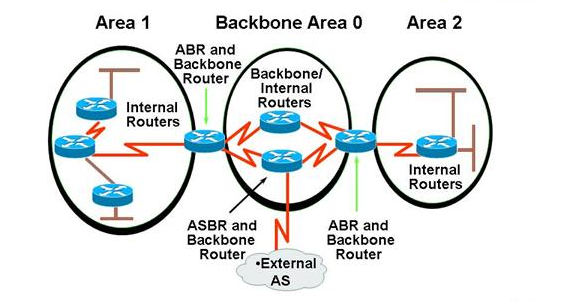In small networks, there not too much routers, there are not too much updates, the LSDB is small so the Djisktra calculation is quick and it doesn’t consume much resources. However in huge networks we can face precise opposite situation:
- Frequent SPF algorithm calculations – in large networks, changes are inevitable. So the OSPF consume much of routers CPU cycles
- Large routing tables – routing tables become very big. We can summarize the networks only at ABR/ASBR which are borders between areas or different routing protocols
- Large LSDB – every router in OSPF must maintain the topology of entire network. Bigger network = bigger LSDB.
Assuming proper OSPF design and configuration, using multiple area concept brings vanish these disadvantages:
- In multiple area concept updates are kept within an area. They are not extend to other areas. Therefore routers affected by change are only within an area
- routing tables can be smaller when proper route summarization is implemented at ABRs. Remember, route summarization cannot be implemented anywhere beside ABR/ASBR (Area border router/Autonomous system border router)
- LSDB is build from LSAs. Number of LSAs necessary to send between routers can be reduced by using multiple area concept in OSPF
OSPF uses two layer area hierarchy:
- Backbone area – primary function of backbone area is to interconnect all areas together. Every area in OSPF must be connected via backbone area (can be bypassed using virtual links, explained later). Backbone area is designed as a CORE area. You wont often find end users connected to this area, when using multiple area concept.
- Regular (nonbackbone) area – primary function of this area is to connect users and resources together. Regular areas are grouped based on geographical or functional purposes. You can reach other regular areas only by using backbone area. Regular areas have several subtypes:
- Stub area – area that doesn’t allow external routes to be propagated through. Instead, external routes are propagated as a default route by ABRs. All routers within area must be configured as a stub to maintain neighbor relationship. There is a stub flag field in hello protocol which must match.
- Totally stub area – area that doesn’t allow external (LSA type 5) and summary routes (summary in meaning of LSA type 3 and 4), instead propagating them as one default route. All routers within area must be configured as stub routers. ABRs connected to area must be configured as a totally stub.
- Not-so-stubby area – area that doesnt allow by default external routes to be propagated through, however this rule can be bypassed and some external routes can be propagated if necessary
- Totally not-so-stubby area – same as nssa but in addition doesn’t allow summary routes to be propagated throght.
Area terminology
We recognize different types of OSPF routers in areas:
- Internal routers – Routers that have all the interfaces within same area. All routers within same area have same LSDB.
- Backbone routers – Routers that have at least one interface connected to backbone area
- Area border routers (ABRs) – Routers that have interfaces attached to separate areas. Maintain different separate LSDBs for each area. They route traffice between areas. ABRs are the only points where route summarization can be configured. ABRs separate LSA flooding zones.
- Autonomous system boundary router – Routers that have at least one interface connected to different routing protocol such as EIGRP or to different OSPF routing domain. Only ASBRs can summarize external routes redistributed into OSPF.
Important note! Router can be more than one router type as you see in picture below – backbone router is also ABR.
